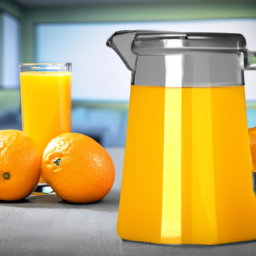I like to kick off my day with a refreshing glass of orange juice. However, have you ever thought about how much a gallon of orange juice could cost? The price of orange juice can vary depending on factors like the type of oranges used and the store you purchase it from.
In this article, I’ll dive into the factors that affect the price of orange juice, the average cost of a gallon in the United States, and tips for saving money on this beloved beverage. Orange juice is a staple in many households, but it’s important to understand the economic and environmental impact of our consumption.
By exploring the factors that contribute to the price of orange juice, we can make informed decisions about our purchases and potentially save money in the process. So, let’s take a closer look at the world of orange juice and explore the different varieties, nutritional value, and industry trends.
Key Takeaways
- The average cost of a gallon of orange juice in the US is around $4.50, but the price can vary depending on the origin and whether it is organic or non-organic.
- Retailer prices for a gallon of orange juice range from Walmart being the most affordable to Whole Foods being the most expensive.
- To save money on orange juice purchases, compare prices at different retailers, look for discounts and promotions, buy in bulk, and use coupons and loyalty programs.
- While orange juice is packed with essential nutrients and can boost the immune system and improve heart health, its high sugar content should be consumed in moderation. Additionally, consumers should consider the economic and environmental impact of orange juice production and be aware of the ethical and sustainable practices of the industry.
Understanding the Factors that Affect the Price of Orange Juice
Want to know why the price of orange juice fluctuates? Let’s explore the various factors that impact the cost of this delicious morning staple.
One of the main factors affecting orange juice prices is the supply and demand dynamics in the market. When there’s an increase in demand for orange juice, the price tends to go up. Similarly, when the supply of oranges used to make juice is low, the cost of producing orange juice goes up, resulting in a higher price for consumers.
Another factor that affects the price of orange juice is the weather. Orange trees require specific weather conditions to grow and produce fruit. When there’s a drought, hurricane, or frost, the production of oranges is impacted, resulting in a decrease in supply and an increase in price.
Additionally, transportation costs, marketing expenses, and storage costs also impact the price of orange juice.
With all these factors in mind, let’s take a closer look at the average cost of a gallon of orange juice in the United States.
Average Cost of a Gallon of Orange Juice in the United States
The average price for a 128 fluid ounce container of orange juice in the US is around $4.50, which is a reasonable cost for most households. However, the cost may vary depending on the origin of the oranges used to make the juice. Imported oranges tend to cost more, and this can reflect in the price of a gallon of orange juice. Additionally, the cost of organic orange juice is higher than that of non-organic options due to the production process involved.
Tariffs are another factor that can impact the price of orange juice in the US market. When tariffs are imposed on imported oranges, the cost of producing orange juice in the US increases, and this eventually leads to a hike in the price of the beverage. As a result, consumers may have to pay more for orange juice than they ordinarily would.
With these factors in mind, it’s essential to consider the price of orange juice when making a purchase. When comparing prices at different retailers, note that some stores may offer discounts on certain brands or quantities of orange juice. This can significantly affect the cost of a gallon of orange juice and is worth exploring before making a purchase.
Comparison of Prices at Different Retailers
It’s incredible how retailers can vary in price for this refreshing and essential beverage. When looking for orange juice, there are many retailer options to choose from, each offering their own unique prices.
Here are three examples of how different retailers compare in price for a gallon of orange juice:
-
Walmart: At Walmart, a gallon of orange juice can be found for around $4.00. This is the most affordable option when compared to other retailers.
-
Whole Foods: For those looking for organic or specialty orange juice, Whole Foods is an option. However, their prices are significantly higher, with a gallon of orange juice costing around $6.00.
-
Target: Target falls somewhere in between Walmart and Whole Foods, with their gallon of orange juice priced at around $5.00.
When considering these price comparisons, it’s important to note that they may vary by location and time of year. However, by taking the time to compare prices at different retailers, consumers can save money on their orange juice purchases.
Looking to save even more money on orange juice purchases? Check out the next section for some tips on how to do so.
Tips for Saving Money on Orange Juice
When it comes to saving money on orange juice, I’ve found that buying in bulk is a great way to cut down on costs.
I also make sure to keep an eye out for coupons and discounts offered by my local grocery stores.
Finally, I’ve started making my own juice at home using fresh oranges, which not only saves me money but also ensures that I know exactly what ingredients are going into my juice.
Overall, these three tips have helped me save money on orange juice without sacrificing quality.
Buying in Bulk
Hey, you savvy shopper! If you’re looking to score some serious savings, buying orange juice in bulk is like hitting a home run – you’ll get more juice for your squeeze!
Here are some buying strategies and storage solutions to ensure you get the most out of your purchase:
-
Look for deals: Many stores offer bulk discounts on orange juice, so keep an eye out for sales and promotions. You can also check online retailers or wholesale clubs for even better deals.
-
Check the expiration date: Make sure to check the expiration date before buying in bulk. While orange juice generally has a long shelf life, you don’t want to end up with too much juice that will go bad before you can consume it.
-
Store properly: Once you’ve bought your orange juice in bulk, make sure to store it properly. Keep it in the refrigerator and use airtight containers to prevent spoilage and extend its shelf life.
Buying in bulk can save you a lot of money in the long run, especially if you’re a regular orange juice drinker. Now that you know how to make the most of your bulk purchase, let’s move on to the next strategy – using coupons and discounts to save even more!
Using Coupons and Discounts
Looking to save some cash on your next grocery trip? You can maximize your savings by utilizing coupons and discounts on your favorite beverages.
Using digital coupons, in-store promotions, and loyalty programs can help you find deals for orange juice and other grocery items. Many grocery stores offer digital coupons that can be clipped and applied to your purchase at checkout. In-store promotions, such as buy one get one free, can be a great way to stock up on orange juice and save money at the same time. Loyalty programs, like those offered by many grocery stores, can provide additional discounts and perks for frequent shoppers.
Another way to save money on groceries is by using apps and websites that help you find deals and discounts. Some popular apps include Ibotta, Checkout 51, and Coupons.com. These apps offer rebates and coupons that can be applied to your grocery purchases, including orange juice. By taking advantage of these tools, you can save money on your grocery bill and still enjoy your favorite beverages.
Transitioning into the subsequent section about making your own juice, you can also save money by making your own orange juice at home.
Making Your Own Juice
To save some extra bucks, why not try making your very own refreshing beverage at home using fresh oranges and a simple juicer? It’s a fun and easy way to add a touch of creativity to your daily routine.
There are plenty of juice recipes available online, but one easy option is to simply peel and juice a few oranges and enjoy the natural sweetness of the fruit. To enhance the flavor, consider adding a squeeze of lemon or lime, or even a pinch of ginger or cinnamon.
When it comes to juicing equipment, there are many options available, from affordable manual juicers to high-end electric models. The type of juicer you choose will depend on your budget and personal preferences, but keep in mind that a good juicer can make all the difference in the quality of your juice.
With a little experimentation and some creativity, you can make delicious and nutritious orange juice at home without breaking the bank.
And speaking of nutrition, did you know that orange juice is packed with vitamins and minerals that can boost your health and wellbeing? From vitamin C to folate, potassium, and more, orange juice is a great way to get your daily dose of essential nutrients.
So why not try making your own juice today and enjoy all the benefits that this delicious beverage has to offer?
Health Benefits of Orange Juice
Drinking orange juice regularly can provide numerous health benefits, such as boosting your immune system and improving heart health. The high Vitamin C content of orange juice makes it a great choice for those looking to strengthen their immune system. In fact, one cup of orange juice contains over 100% of the recommended daily intake of Vitamin C.
This essential vitamin helps to prevent and fight off infections, as well as promote healthy skin and tissue repair. Not only is orange juice a great source of Vitamin C, but it also contains other important nutrients like potassium, folate, and thiamin.
Potassium helps to regulate blood pressure, while folate plays a crucial role in DNA synthesis and cell division. Thiamin, also known as Vitamin B1, is important for healthy brain function. So, the next time you reach for a glass of orange juice, remember that it’s more than just a delicious beverage – it’s packed with essential vitamins and nutrients that can give your body a much-needed boost.
Moving onto the subsequent section about the nutritional value of orange juice, we’ll take a closer look at the specific amounts of these important nutrients found in each serving.
Nutritional Value of Orange Juice
You won’t believe the amount of essential vitamins and nutrients packed into each glass of this deliciously refreshing beverage. Orange juice is a great source of vitamin C, which plays a critical role in our immune system, helps wounds heal faster, and aids in the absorption of iron from plant-based foods. In fact, just one glass of orange juice contains more than 100% of the daily recommended intake of vitamin C.
However, it’s important to note that not all orange juice is created equal. Some brands may contain added sugars or artificial flavors, which can have a negative impact on our health. It’s always best to choose pure, freshly squeezed orange juice or those labeled as ‘not from concentrate’ to ensure that you’re getting the most nutritional benefits from your beverage.
With that being said, let’s explore the different varieties of orange juice and how they differ in taste and nutritional value.
Different Varieties of Orange Juice
As I mentioned earlier, orange juice is loaded with essential vitamins and minerals, making it a nutritious addition to any diet. But did you know that there are different varieties of orange juice? These variations can affect the taste, nutritional value, and price of the juice.
In this section, I’ll explore the different types of orange juice available on the market today.
Firstly, there’s cold-pressed orange juice, which is made by using a hydraulic press to extract the juice from the fruit. This method preserves the natural enzymes and nutrients in the fruit, making it a healthier option.
On the other hand, concentrated orange juice is made by removing the water from freshly squeezed orange juice and then adding it back in later. This process can result in a loss of nutrients and flavor.
Additionally, there are organic and non-organic options available. Organic orange juice is made from oranges that have been grown without the use of synthetic pesticides or fertilizers, making it a more environmentally friendly choice. Non-organic orange juice, on the other hand, is made from conventionally grown oranges that may have been treated with chemicals.
When it comes to choosing orange juice, there are many factors to consider. Whether you prefer cold-pressed or concentrate, organic or non-organic, the choice is ultimately up to you. However, by understanding the different types of orange juice available, you can make a more informed decision that suits your taste, budget, and values.
Speaking of values, in the next section, we’ll explore how orange juice production impacts the environment.
Orange Juice and the Environment
As I’m a concerned consumer, I’ve been wondering about the environmental impact of my favorite breakfast drink: orange juice.
In this discussion, I’ll be exploring how sustainable the production of orange juice is, how the packaging and transport of orange juice contributes to waste, and what steps are being taken to mitigate the environmental impact of orange juice production.
It’s important to consider these factors in order to make informed choices as consumers and to reduce our individual ecological footprint.
Sustainability of Orange Juice Production
The sustainability of orange juice production is a critical issue that must be addressed to ensure the long-term availability and affordability of this popular beverage. To achieve this, sustainable farming practices and fair trade practices must be implemented. Sustainable farming practices include reducing the use of pesticides and fertilizers, implementing crop rotation, and conserving water. Fair trade practices ensure that farmers receive fair prices for their products and are not exploited by large corporations.
Implementing sustainable farming and fair trade practices not only benefits the environment, but it also benefits the farmers and the consumers. By reducing the use of harmful chemicals and conserving resources, we can ensure that orange juice production is sustainable for generations to come. Furthermore, by supporting fair trade practices, we can ensure that farmers receive a fair price for their hard work and are able to provide for their families. It is important to prioritize sustainability and fairness in the production of orange juice to ensure that it remains a viable and affordable option for consumers in the future.
As we consider the sustainability of orange juice production, we must also address the issue of packaging and waste.
Packaging and Waste
One way to reduce the environmental impact of the popular beverage is by implementing sustainable packaging practices. Orange juice manufacturers can reduce waste by using eco-friendly materials such as biodegradable or compostable packaging. They can also minimize packaging by using smaller containers that require less material and energy to produce.
Additionally, manufacturers can implement recycling programs to encourage consumers to properly dispose of their used packaging. Sustainable packaging not only helps reduce waste but can also positively impact a company’s bottom line. By using recycled materials or reducing the amount of packaging used, companies can save on production costs.
Furthermore, consumers are becoming increasingly aware of the environmental impact of their purchases and are more likely to choose products with sustainable packaging. Implementing sustainable packaging practices can not only benefit the environment but also improve a company’s brand image and customer loyalty.
As the orange juice industry continues to grow and evolve, it’s important to stay up-to-date on industry trends. One such trend is the rise of organic and non-GMO options, as consumers become more health-conscious and environmentally aware.
Orange Juice Industry Trends
Hey folks, wanna know what’s shaking in the orange juice industry lately? Check it out – gallon prices are on the rise! In fact, according to recent trends, the average price of a gallon of orange juice has increased by 10% in the last year. This is largely due to a decrease in orange juice production, caused by the impact of climate change on the orange juice export market.
To give you a better idea of the current state of the industry, here’s a table summarizing some key figures:
| 2019 | 2020 | 2021 | |
|---|---|---|---|
| Orange Juice Production (million tons) | 2.7 | 2.4 | 2.1 |
| Orange Juice Exports (million tons) | 1.5 | 1.3 | 1.0 |
| Average Gallon Price ($) | 4.50 | 4.75 | 5.25 |
As you can see, there has been a significant decrease in both orange juice production and exports in the last two years, leading to a higher average price per gallon. Additionally, with the impact of climate change on citrus crops, it is uncertain whether this trend will continue in the future. It’s important for consumers to be aware of these industry trends and make informed choices when purchasing their orange juice.
Frequently Asked Questions
How long does orange juice stay fresh once opened?
As a juice enthusiast, I always make sure to consume my orange juice within 7-10 days of opening to ensure maximum freshness. Proper storage tips include refrigeration and avoiding exposure to sunlight. When it comes to choosing the best juicer, research various types and read reviews to make an informed decision.
Can I freeze orange juice to make it last longer?
Yes, I freeze orange juice to make it last longer. It helps to retain its nutritional value and taste. Additionally, freezing allows me to buy larger quantities at a lower price point.
What is the difference between fresh-squeezed orange juice and bottled orange juice?
Fresh-squeezed orange juice trumps bottled with its superior taste and nutrient content. Juicing techniques vary, but hand-pressed is preferred for maximum flavor. Make your own by cutting oranges in half and using a juicer or squeezing by hand.
How much sugar is typically added to a gallon of orange juice?
The sugar content in a gallon of orange juice can vary depending on the brand and whether it’s fresh or bottled. However, on average, a gallon of orange juice contains around 128 grams of sugar, which can impact its nutritional value.
Is it better to buy organic orange juice, and if so, why?
Is it worth buying organic orange juice? Yes, the benefits outweigh the cost difference. Organic juice is free of harmful pesticides, contains more nutrients, and supports sustainable farming practices.
Conclusion
Well folks, after diving into the world of orange juice, I’m feeling quite enlightened. Who knew that the price of a simple gallon of orange juice could be influenced by so many factors?
From weather patterns to consumer demand, the price can fluctuate greatly. But fear not, my fellow orange juice enthusiasts, there are ways to save money on this beloved beverage. By shopping around and taking advantage of sales and coupons, we can enjoy our daily dose of vitamin C without breaking the bank.
Let’s not forget about the health benefits of orange juice – it’s not just delicious, it’s good for us too! So let’s raise a glass (or a jug) to the wonderful world of orange juice.
Whether you prefer pulp-free or with pulp, organic or conventional, let’s appreciate the hard work and dedication that goes into bringing this refreshing drink to our tables. And let’s not forget to do our part in supporting sustainable and environmentally-friendly practices within the orange juice industry.
Cheers to orange juice – may it continue to quench our thirst and nourish our bodies for years to come!
Ilana has been a vegan for over 10 years. She originally made the switch for health reasons, but soon found herself becoming more and more passionate about the ethical and environmental implications of a vegan lifestyle. Ilana is the author of The Graceful Kitchen, a blog all about veganism. She loves to cook up delicious and nutritious vegan meals, and share her recipes with others who are interested in leading a cruelty-free life. Ilana is also a strong advocate for using whole foods as the foundation of a healthy diet, and believes that going vegan is one of the best ways to achieve this.









